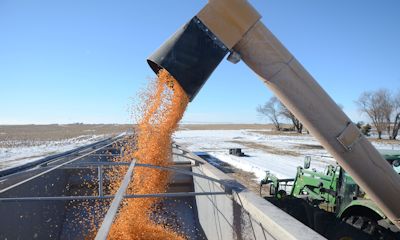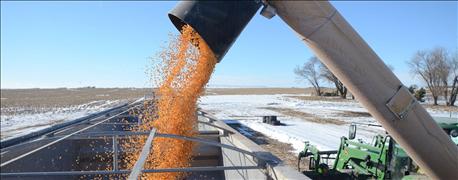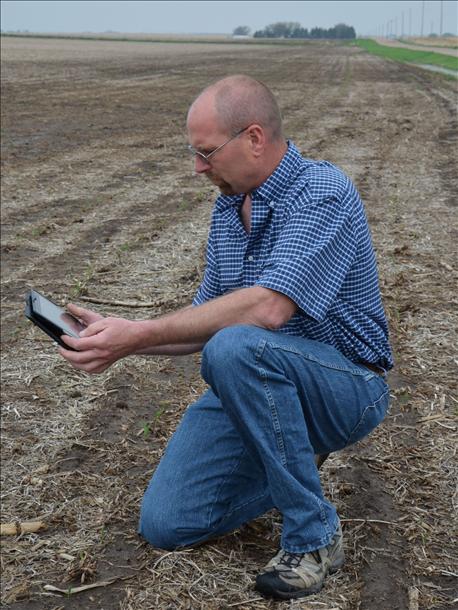
When it comes to improving margins, there are two factors to consider: yields and input costs. It's something more and more producers are paying attention to as margins get tighter.
However, in Brad Williams' case, scrutinizing every dollar invested relative to dollar returned has been a habit ever since he started farming, whether it's different nitrogen rates, different hybrids, lime applications, or micronutrient applications.

IMPROVING ROI: A grain hopper is loaded on Williams Farms near Cedar Bluffs in January. Something on everyone's mind this year is improving return on investment in the wake of tight margins, Brad Williams notes there are two parts to the equation: it takes managing both input costs and yield.
"One of the ways to reduce your cost per bushel is to increase your yield. It's tough. We're looking at cutting costs as much as we can," says Williams, who farms with his brother, Bruce near Cedar Bluffs. "But, for example, if we cut fertility too much, eventually we're going to be cutting yields, which will eventually raise our cost of production per bushel. So we need to figure out how to maintain or increase yields for less cost."
So, it may not be a good idea to simply cut back on less productive acres. The question is why are those acres less productive?
Getting the formula right
What works on one field or even part of a field may not work elsewhere – the formula changes depending on location and the growing season. This is where on-farm research and aggregated data come in handy. Williams and assistant farm manager Cody Weitzenkamp have been involved in the Nebraska On-Farm Research Network for the last ten years, and have participated in numerous trials, including variable-rate nitrogen, variable rate seeding, and micronutrients through the years.

STRIKING A BALANCE: "One of the ways to reduce your cost per bushel is to increase your yield. It's tough. We're looking at cutting costs as much as we can," says Brad Williams. "But, for example, if we cut fertility too much, eventually we're going to be cutting yields, which will eventually raise our cost of production per bushel. So we need to figure out how to maintain or increase yields for less cost."
For example, one of the biggest decisions every year is hybrid selection. Williams relies on trial data to identify which hybrid will work best on his soils during a given year. Hybrid selection is closely tied to other factors like population and fertility.
Williams also variable-rate applies nitrogen, adjusting rates based on on-farm research results and grid sampling, and splits nitrogen applications throughout the season to mitigate losses and ensure more goes to the crop.
~~~PAGE_BREAK_HERE~~~
Sometimes on-farm research helps identify when inputs don't pay. For example, Weitzenkamp notes while they haven't realized an economic return on micronutrient applications yet, they may need to get their nitrogen, phosphorus and potassium to the right levels first. "Once you get your fertility up to where it needs to be, you move on to your next limiting factor – and that might include micronutrients," he says.
Fungicide applications are similar. Whether or not it pays depends on the year, and different timings of fungicide applications yield different results. "It might work well for one grower, but he has to have disease to see the benefits. If we don't have any disease it's not going to benefit us," Weitzenkamp says. That's why scouting and testing out different timings of application through on-farm research are necessary.
On-farm research is key
In 2015, the Nebraska On-Farm Research Network had 82 projects representing 66 growers, many who identified inputs or management practices like these they wanted to evaluate on their farm, notes Keith Glewen, University of Nebraska-Lincoln Extension educator who has worked with farmers conducting on-farm research for many years.
"When prices and the economy are in the tank, there's a group of products that surface with the claim of saving money," Glewen says. "The On-Farm Research Network can help growers validate what they think they know on specific fields. If growers want to determine the payback from a management practice or input, we are more than happy to sit down with them and talk about how they can develop an on-farm research effort to answer that question."
Of course, certain protocol should be followed, like replicating trials and testing inputs and management practices over multiple years, and testing one variable at a time.
"What works for me isn't going to work for my neighbor consistently and what works for my neighbor isn't going to work for me, because we've got different management styles and we're trying to accomplish different goals," Williams says. "On-farm research is very important to be able to comfortably say whether something is going to work for me."
Read more about Williams's farming operation and the benefits of on-farm research in the March Nebraska Farmer.
About the Author(s)
You May Also Like






